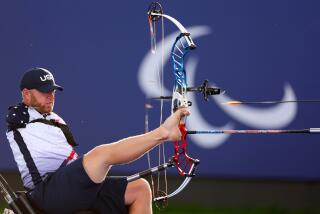Fencers Take a Stab at a Tradition-Filled, Swashbuckling Sport
- Share via
In a spacious hall in Culver City, a dozen or more faceless white-clad duos lunge at one another, jabbing with precise aggression. Athletic shoes thump and squeak on the glossy hardwood floor.
At the far end of the room, a duel is beginning. Opponents aim their weapons heavenward, a move that a few centuries ago signified a salute before death.
Such traditions are played out every day at the Westside Fencing Center, Southern California’s premier fencing venue, where everyone from Olympic hopefuls to amateurs trains in the centuries-old sport.
For about 350 customers a year, it’s a place where fantasy, tradition and fitness converge. Between the intense muscle work--lunges, thrusts and hops--and the mental concentration required (one devotee described it as a physical form of chess), fencing keeps its students in prime physical and mental shape. And unlike other sports, it appeals to long-squelched fairy tale notions of swashbuckling and sword fighting.
Many fencers say that as youngsters they clutched discarded cardboard tubes and dueled “to the death” with pesky siblings.
They gazed with awe as Errol Flynn and Robin Hood bested cruel villains with the swish of a gleaming sword.
“You see this stuff in the movies when you’re a kid and it gets in your head,” said Victor Pineschi, a city periodontist and devoted Westside student. “There’s no one who grew up not wanting to fence.”
The same applies to youngsters today. Yoni Pressman, 13, recently read “The Three Musketeers” and became fascinated with the notion of sword fighting. He travels from Sherman Oaks once a week for lessons and, after two sessions, he hopes to continue.
But if Yoni is like most beginners, chances are he won’t. Few equate the elegant jousting that is the stuff of fiction with fencing’s grueling movements, which initially feel very awkward.
*
Duels begin with fencers’ feet shoulder-width apart and out-turned. Blade in hand, beginners often want to run at their opponents and stab. But the first lesson is control.
Hopping forward and back to attack and retreat, fencers must carefully position their feet, lifting the front foot first, then pushing off from the rear and landing simultaneously. It’s a cross between ballet and boxing.
That’s just the footwork. Handling the one-pound, 40-inch-long weapons to perform a seemingly infinite list of blade moves poses a new set of physical challenges.
And then there are the 250-plus rules and more than 30 official penalties for such offenses as retreating out of bounds and arguing with a referee.
After mastering all that, the rest of the game is simple: Stab or slash your opponent with at least a pound of electronically measured pressure and you get a point.
Whoever gets five hits in five minutes--or 15 hits in nine minutes, depending on the type of match--is the victor.
For fencing enthusiasts such as Sam Epstein, it’s all worth it. A cherubic, swift-bladed student, the retired aerospace model airplane engineer first tried fencing at age 8. Although he was not a natural and stopped taking lessons, thoughts of the sport nagged at him.
More than two decades later, he finally joined a local group and is more devoted than ever today, at age 74.
“I am still a lousy fencer,” he said with a grin, cradling his blade, “but I’ll never give it up. Maybe I’ll get there if I work hard enough.”
*
Hundred-year-old fencing lithographs and historical photographs adorn the walls of Westside Fencing Center, reminding students that their sport is one of the world’s oldest.
The thick white uniforms that resemble straitjackets hearken back to 17th-Century France and the first days of swordplay as a sport. To help keep score, fencers dipped their blades in ink and left marks on opponents’ uniforms.
Today, blades are wired to score-keeping machines and the nearly seamless uniforms protect torsos from scratches and bruises.
The sport’s links to tradition and bygone eras have made it a cinematic staple.
Thanks in large part to movies such as “Hook” and “The Princess Bride,” which inspire many armchair fencers to sign up for lessons, the sport has attracted a steady stream of newcomers in recent years.
Most notable, in the last decade the percentage of U.S. Fencing Assn. members who are 17 and under has jumped to 30% from 1%, according to USFA Executive Director Bill Goering.
As a child, Westside Fencing Center co-founder and fencing master Ted Katzoff had a Prince Valiant outfit and played with a plastic sword.
Today, he insists that the sport is about more than winning and losing. He tells students it is about marking personal improvement and coming to a better understanding of one’s self. His center, which normally charges $22 an hour for lessons and rented equipment, says it does not charge students who cannot afford to pay.
“Ted always tells me during lessons to stop thinking so much,” said Lucia Vincent, an actor who started taking lessons six months ago to work on her skills of physical expression. “You have to concentrate and feel it. It’s about trusting yourself.”
More to Read
Go beyond the scoreboard
Get the latest on L.A.'s teams in the daily Sports Report newsletter.
You may occasionally receive promotional content from the Los Angeles Times.








